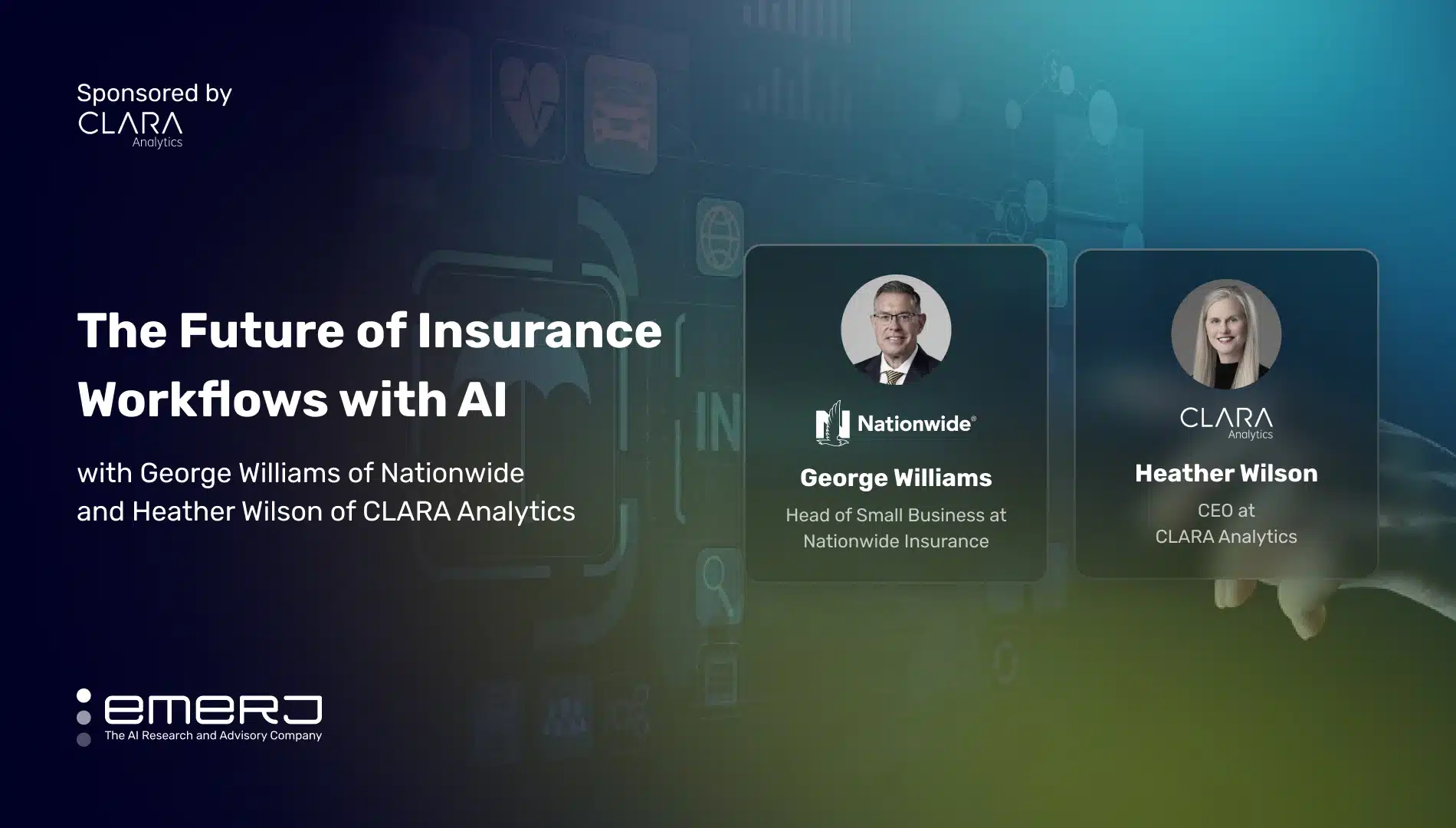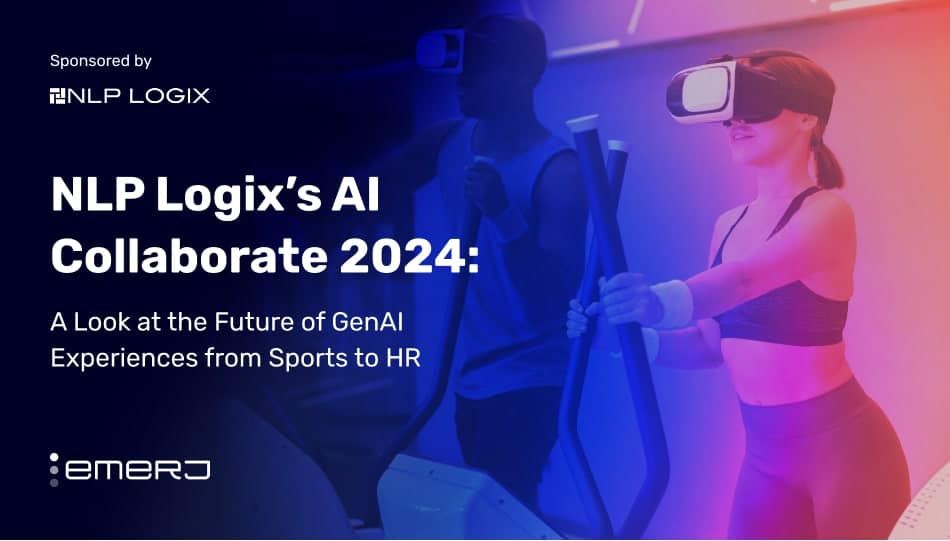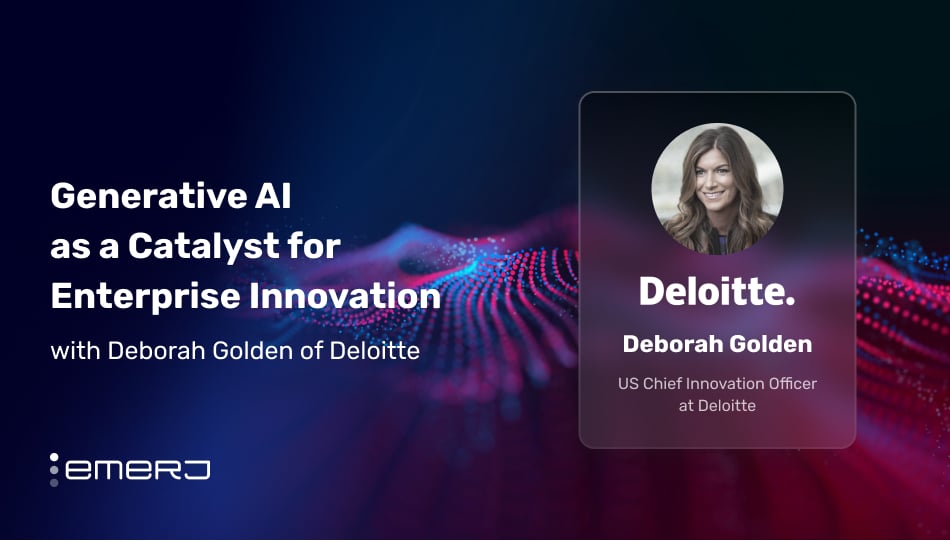This interview analysis is sponsored by CLARA Analytics and was written, edited, and published in alignment with our Emerj sponsored content guidelines. Learn more about our thought leadership and content creation services on our Emerj Media Services page.
Even simple applications of deterministic, first-generation AI stand to transform the insurance enterprise over time. Yet the broad possibilities of new, generative intelligent capabilities and platforms stand to alter how the fundamentals of the industry will work going into the future.
As evidenced by the forward-looking 2021 McKinsey report “Insurance 2030—The impact of AI on the future of insurance“, the insurance industry is transitioning away from workflows based on ‘detecting and repairing’ and toward a new infrastructure based on ‘predicting and preventing.’ In other words, insurance carriers are using AI to earn a presence in their customers’ lives well before significant losses or accidents occur.
Emerj Senior Editor Matthew DeMello recently sat down on the ‘AI in Business’ podcast with George Williams, Head of Small Business at Nationwide Insurance, and Heather Wilson, CEO of CLARA Analytics, to talk about leveraging AI to enhance claims handling and underwriting processes and the need for improved data governance in the insurance industry to make these substantial transitions possible.
In the following analysis of their conversation, we examine three key insights:
- Driving document processing for proactive claim management: Enabling more proactive decision-making and reducing administrative burden using machine learning and predictive analytics to digitize and analyze incoming claims to better predict their progress.
- Optimizing claims management with AI alerts: Implementing machine learning-driven systems to alert claims adjusters about critical cases in real-time, enabling proactive management and enhancing empathy by focusing the attention of claims handlers where it is most needed to resolve the claim.
- Adopting a collective data approach: Streamlining data collection by collaborating across insurers, brokers, and other stakeholders to create a more integrated system, focusing on transforming and utilizing data efficiently rather than just capturing.
Listen to the full episode below:
Guest: George Williams, Head of Small Business, Nationwide Insurance
Expertise: Insurance, Solution Design, Change Management
Brief Recognition: George is the Head of Small Businesses at Nationwide Insurance. He has spent more than half of his career in the insurance industry. He earned his MBA from the NYU Stern School of Business.
Guest: Heather Wilson, CEO of CLARA Analytics.
Expertise: Artificial Intelligence, Cognitive Systems, Graph Analytics
Brief Recognition: Heather is the CEO of CLARA Analytics. She has over a decade of executive experience in data, analytics, and AI, including as the Global Head of Innovation and Advanced Technology at Kaiser Permanente, the Chief Data Officer at Citigroup, and the Chief Data Officer of AIG.
Leveraging AI for Proactive Claim Management
George opens the conversation by talking about how AI is improving the claims and underwriting processes throughout the insurance space in three critical areas:
1. Administration of Processes: AI helps insurance organizations ingesting incoming materials through digitalization, whether for claims or underwriting. Some tasks, such as summarizing incoming information potentially using generative AI, can help adjusters and underwriters by automating the entry of data into systems, reducing administrative burden.
2. Decoding the “Genome” of Claims: Analyzing claims when they first arrive to predict how they might evolve. For instance, understanding what a claim will “grow into” helps adjusters manage it more effectively from the start. George uses the metaphor of a claim evolving into a car, giraffe, or human being to illustrate how different types of claims require different handling from the beginning.
3. Decision Support Tools: The final stage involves continuously updating claims as new information arrives from news, vendors, or public sources to help adjusters manage the claim proactively. It allows adjusters to make better, informed decisions throughout the claim’s life rather than reacting to issues in a claim as they arise.
Heather underscores George’s points by emphasizing that AI acts as a valuable partner in the insurance industry by predicting claim outcomes based on patterns learned from millions of cases. Doing so, she notes, allows for proactive case management, similar to triaging patients in a hospital, helping adjusters anticipate issues early.
She articulates that she views AI as a “second set of eyes” that takes on routine tasks, enabling claims professionals to focus on complex decision-making. Rather than replacing humans, AI augments their abilities to ensure better outcomes for both claimants and insurers.
Optimizing Claims Management with AI Alerts
George further discusses the role of AI as a supportive tool for adjusters, functioning as “models upon models” that provide various levels of interaction. Examples can range from direct conversations with an AI co-pilot platform to simple prompts, like suggesting a settlement range based on extensive data analysis. He agrees with Heather’s idea of “intelligence augmentation,” emphasizing that AI is not meant to replace humans but to enhance their decision-making capabilities.
Heather expands on George’s points by suggesting AI provides a paradigm shift in how claims adjusters manage their workload.
Currently, adjusters often follow a routine of checking on their cases every 90 to 150 days. Instead, Heather proposes a new approach where AI serves as an indicator, alerting adjusters when they need to focus on specific cases. The new AI-enhanced workflow helps adjusters “find the needle in the haystack,” allowing them to address issues proactively rather than periodically.
She also emphasizes that an AI-driven alert approach brings empathy to the adjuster’s role. By using AI to highlight the most pressing cases, adjusters can focus more on effectively supporting the claimant.
Heather likens the new process to using a GPS, where AI-enhanced systems provide different routes and predicted costs based on extensive historical data. More detailed guidance allows adjusters to make more informed, empathetic decisions, improving their service to claimants while managing their caseload more efficiently.
In continuation, George argues that the actual product insurers offer is the claims handling experience, not the policy itself. A positive experience relies on making “better, faster, smarter” decisions, which means leveraging technology to drive responsiveness, transparency, and communication:
“There’s also a cost component to it. The combined ratio effectively has two major components: There’s an expense piece, and there’s a loss ratio piece. Every company wants to make an underwriting profit. And so you want your combined ratio ideally to come in under 100, and so there’s a constant financial competition to make sure that that’s happening. And there’s a variety of levers to pull. Advancing technologies like AI allows you to manage the expense side, either through deployment on some of the more administrative tasks and processes that we talked about earlier, but also on the loss ratio side, on the indemnity side. Making a better, faster, smarter decision ultimately leads to a more effective indemnity payout.”
–George Williams, Head of Small Business, Nationwide Insurance
George also discusses the ongoing debate in the insurance industry around buy-versus-build strategies for deploying AI initiatives in the insurance enterprise. He ultimately feels that there’s no one-size-fits-all answer; the decision depends on an insurer’s strategic focus and niche.
However, if a company has a unique strength or sees a process as proprietary, then George notes building in-house might be the better option. When others are more specialized in a particular area, then buying becomes more practical. Often, a combination of both is ideal—purchasing external solutions while customizing their integration to maintain a unique edge.
He uses the example of Nationwide working with CLARA Analytics, where they “buy” CLARA’s models but customize how they implement them, creating a proprietary process that suits Nationwide’s needs.
Adopting a Collective Data Approach
George then highlights an industry-wide challenge: the inefficient collection of data. In the process, he points out that data from IoT devices, courts, medical providers, and other sources is often gathered and managed in a fragmented way.
He suggests that insurers, brokers, and other stakeholders could benefit from a more collective approach to data collection, focusing on transforming and using the data uniquely rather than on the inefficient process of capturing it. Transformation and utilization, rather, would streamline operations and ultimately benefit customers.
George then emphasizes the importance of using data to make “better, faster, smarter“ decisions for customers, acknowledging that, while there are significant opportunities with AI, there are also challenges. He details the immense complexity of sourcing, storing, cleaning, and staging data for AI tools.
Additionally, concerns around data privacy, cyber security, regulatory compliance, and data exchange need to be addressed. To manage these challenges, George suggests a cautious and collaborative approach. He advocates for enterprises piloting new technologies gradually, rather than implementing them all at once, and working with specialized vendors to focus on specific objectives. Such a gradual strategy allows companies to navigate risks while continuing to progress toward a more proactive and beneficial use of data and AI.
George also stresses the importance of involving the right experts from the beginning when developing and implementing new use cases. He suggests starting with a broad, collective conversation from team members across the enterprise that includes subject matter experts (SMEs) who understand the core of the use case but may want to avoid handling the technical details of data management themselves.
“It’s bringing the right participants from the various parts of the value chain into that collective conversation at the very beginning and then having the groups decompose and focus on their particular parts. Then you effectively bring them [back] together, making sure that you have a solid governance process around the use cases themselves, filtering through them, seeing how many of those use cases resonate most broadly across the organization. Because when you pilot, it’s ideal to pilot something that’ll benefit a broader population. Because if it does turn out to be successful, you want there to be value in it.”
–George Williams, Head of Small Business, Nationwide Insurance














